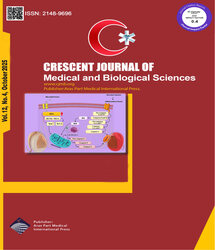

| Original Article | |
| Comparison of Neonatal Arterial Blood Oxygen Saturation Rate Immediately After Birth in Normal and Elective Cesarean Delivery | |
| Fatemeh Mahmoodi1, Asieh Mobaraki2, Zainab Mahmoodi3, Shahnaz Najar4, Mohammad Hossein Haghighi5, Sajad Borzoueisileh6, Soheil Ebrahimpour7 | |
| 1School of Nursing and Midwifery, Yasuj University of Medical Sciences, Yasuj, Iran 2Faculty of Paramedical Sciences, Yasouj University of Medical Sciences, Yasouj, Iran 3Department of Nursing, Faculty of Paramedical Sciences, Yasouj University of Medical Sciences, Yasouj, Iran 4Department of Nursing, School of Nursing and Midwifery, Ahvaz University of Medical Sciences, Ahvaz, Iran 5Ahvaz University of Medical Sciences, Ahvaz, Iran 6Cellular and Molecular Research Center, Yasuj University of Medical Sciences, Yasuj, Iran 7Infectious Diseases and Tropical Medicine Research Center, Babol University of Medical Sciences, Babol, Iran |
|
|
CJMB 2016; 3: 019-022 Viewed : 6270 times Downloaded : 3297 times. Keywords : Cesarean, Delivery, Neonate, Oxygen saturation |
|
| Full Text(PDF) | Related Articles | |
| Abstract | |
Objective: Ninety percent of neonates pass the transition from fetal life to outside uterus successfully, and only 1% needs intensive support for survival. The quantity of oxygen saturation immediately after birth shows the need for resuscitation immediately after birth. The present research was carried out with the objective of comparing saturation rate of arterial blood hypoxia in neonates born with normal vaginal delivery and cesarean method. Materials and Methods: 220 neonates born with elective cesarean section and normal delivery were studied in an analytical-descriptive study. Demographic questionnaire was completed. Then a pulse oxymeter with its sensor fixed on the right wrist of the neonates was used. Heart rate was recorded and the level of oxygen saturation (SaO2) under 90% was considered as hypoxia. To compare the quantitative and qualitative variable between the two groups, paired t test and chi-square test was used, respectively. Pearson correlation test was used to study the correlation between the variables. Results: The age range of mothers was 16-38 years. The mothers’ average age, gestational age and neonates’ weight were not significantly different between groups. The average SaO2 in minutes 1, 3 and 5 was 72%, 81% and 89%, respectively in vaginal delivery, which showed a significant difference compared to cesarean neonates with average of 65%, 75% and 83%, respectively. No significant difference was observed after10 minutes. Also there were not significant statistical correlation between mothers age, number of pregnancies, sex and weight of neonate with SaO2 of arterial blood after 1, 3, 5 and 10 minutes after birth. Conclusion: With respect to the results of the present research SaO2 was higher in neonates of vaginal delivery in comparison to cesarean neonates. Encouraging mothers to delivery vaginally and also using aid-oxygen is proposed for the cesarean neonates at birth. |
Cite By, Google Scholar
Google Scholar
PubMed
Online Submission System
 CJMB ENDNOTE ® Style
CJMB ENDNOTE ® Style
 Tutorials
Tutorials
 Publication Charge
Medical and Biological Research Center
About Journal
Publication Charge
Medical and Biological Research Center
About Journal
Aras Part Medical International Press Editor-in-Chief
Arash Khaki
Deputy Editor
Zafer Akan

















